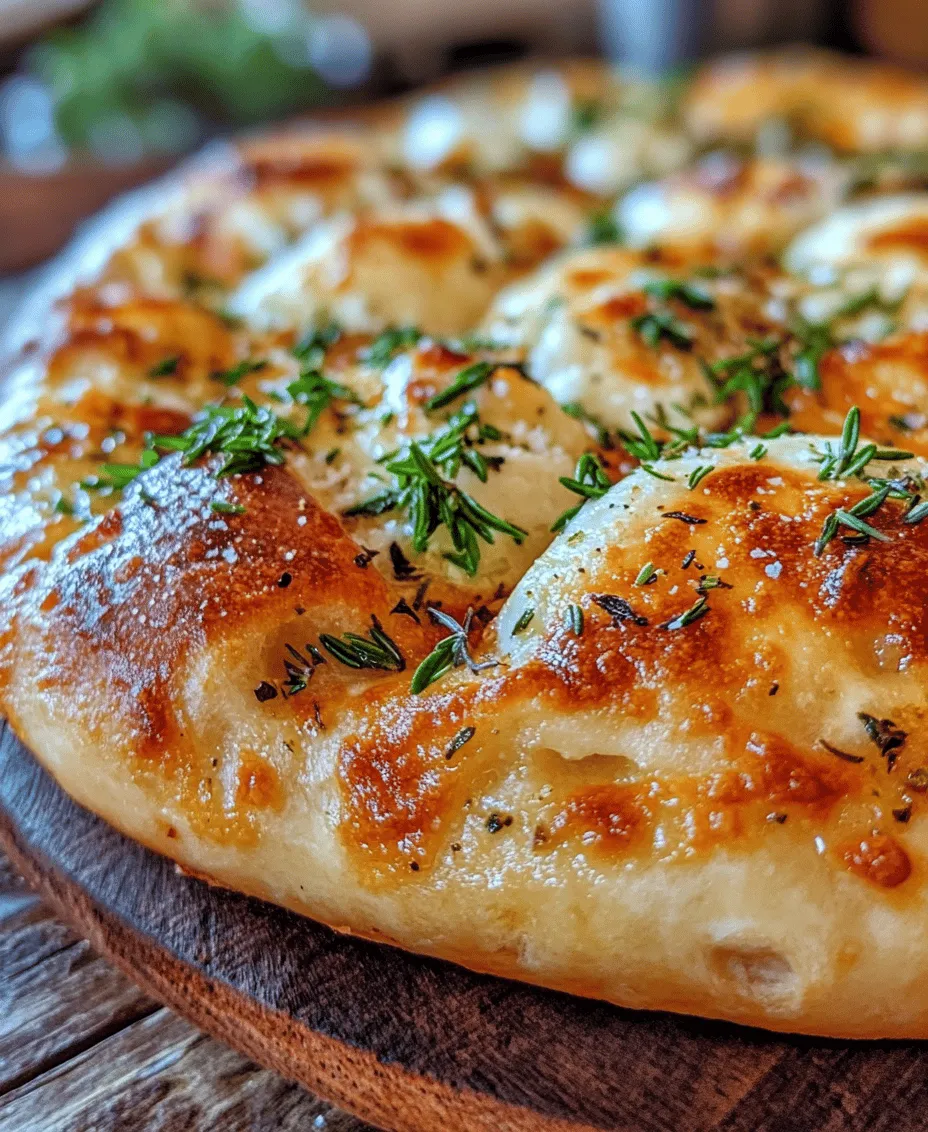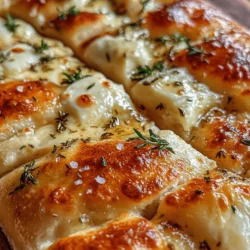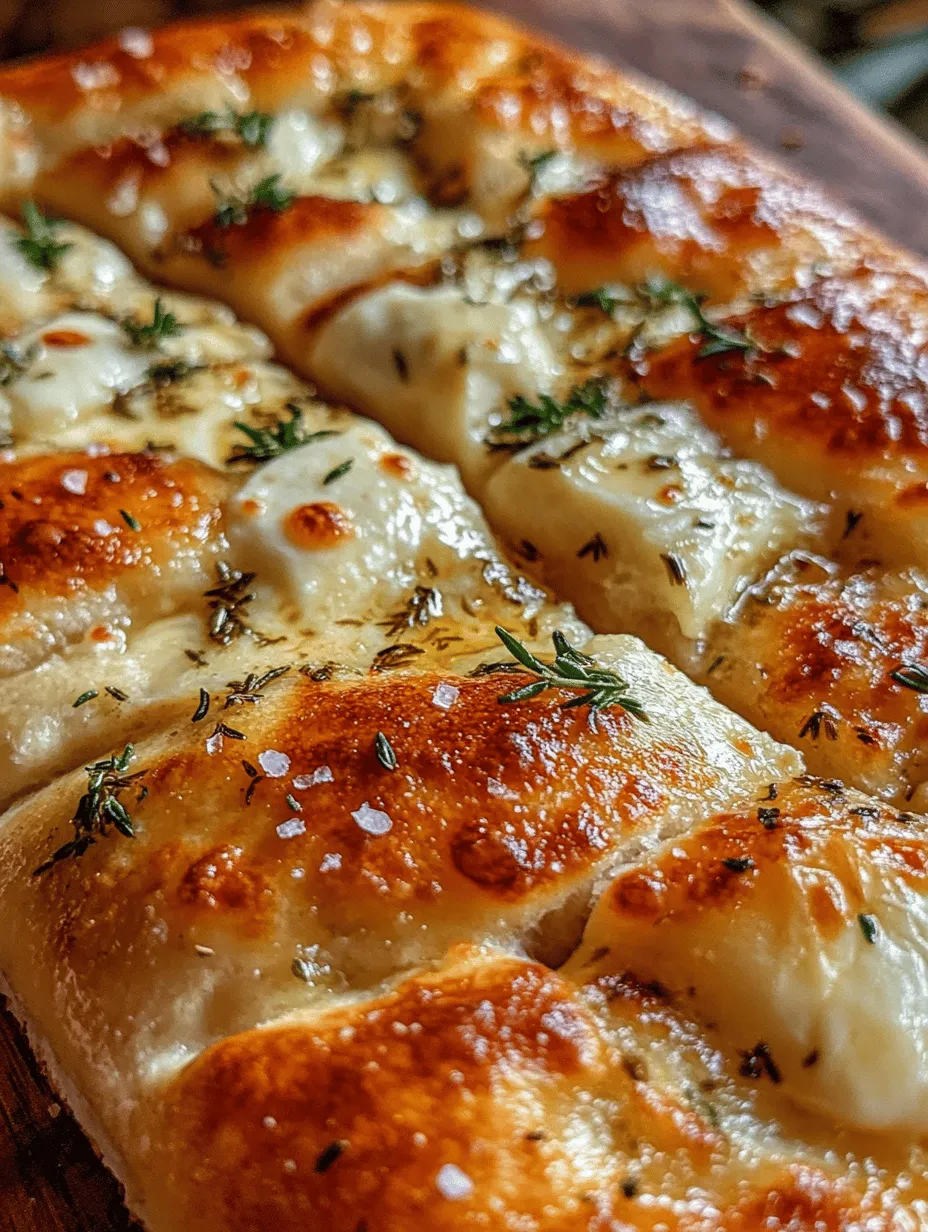Introduction
Focaccia is more than just a type of bread; it is a cherished staple in Italian cuisine, renowned for its rich flavor and versatile nature. Originating from ancient Rome, this flat oven-baked bread has been a part of the Italian culinary tradition for centuries. Historically referred to as “panis focacius,” focaccia was initially a humble bread, often baked in the ashes of a fire. Over time, it evolved into a beloved dish, often topped with herbs, oils, and various ingredients, reflecting the region’s agricultural bounty.
In this recipe, we take the classic focaccia to new heights by incorporating buffalo mozzarella and fresh herbs, creating a delightful blend of flavors and textures. The creamy richness of the buffalo mozzarella pairs beautifully with the aromatic notes of fresh rosemary and thyme, making each bite an irresistible experience. This unique twist not only highlights the quality of ingredients but also pays homage to the traditional Italian focus on fresh, local produce.
Baking bread at home is a rewarding and satisfying experience. The warm aroma of freshly baked focaccia wafting through your kitchen can transform an ordinary day into something special. Homemade bread allows you to control the ingredients, ensuring a wholesome and flavorful result. Plus, there’s something incredibly fulfilling about kneading dough and watching it rise, knowing that you’ve created something delicious from scratch.
Understanding Focaccia Bread
Definition of Focaccia
Focaccia is a flat oven-baked Italian bread that is characterized by its golden crust, tender interior, and rich infusion of flavors. Unlike traditional bread, focaccia is typically thicker and more forgiving, making it a perfect choice for both novice and experienced bakers. It can be served as an appetizer, side dish, or even as the main star of a meal, making it a versatile addition to any table.
Historical Context
The origins of focaccia can be traced back to ancient civilizations, where flatbreads were baked over hot stones or in the ashes of a fire. The Romans embraced this type of bread, adding olive oil and herbs to enhance its flavor. As the centuries passed, focaccia became popular throughout Italy, with each region developing its own variations. From the herb-laden focaccia of Liguria to the cheese-topped varieties of Apulia, this bread reflects the diverse culinary landscape of Italy.
Focaccia has not only stood the test of time but has also evolved to embrace modern culinary trends. Today, it is often enjoyed as a base for sandwiches, a side for soups, or simply dipped in olive oil and balsamic vinegar. Its adaptability makes it a favorite among home cooks and professional chefs alike.
Variations of Focaccia
Focaccia is a wonderfully versatile bread that can be topped with a variety of ingredients to suit personal tastes. Classic variations often include:
– Focaccia al Rosmarino: Topped simply with fresh rosemary and coarse sea salt, allowing the flavors of the bread to shine.
– Focaccia con Cipolle: Featuring caramelized onions, which add sweetness and depth to the bread.
– Focaccia Dolce: A sweet version made with sugar and topped with fruits or sweet spices, perfect for dessert.
In addition to these traditional styles, contemporary bakers have embraced creativity, experimenting with toppings such as olives, sun-dried tomatoes, and even seasonal vegetables. The addition of buffalo mozzarella and fresh herbs in this recipe is a delightful example of how focaccia can evolve while remaining true to its Italian roots.
Ingredients Breakdown
To create our delicious buffalo mozzarella herb focaccia, we’ll need a few essential ingredients, each playing a crucial role in the final product.
– All-Purpose Flour: This is the backbone of our focaccia. All-purpose flour provides the right balance of protein and gluten, resulting in a light and airy texture. For those looking for an even chewier bread, bread flour can be substituted due to its higher gluten content.
– Active Dry Yeast: Yeast is the magic ingredient that helps our dough rise. When activated, the yeast ferments the sugars in the flour, producing carbon dioxide gas that creates air pockets in the bread. This is what gives focaccia its characteristic lightness and texture.
– Olive Oil: A key player in focaccia, olive oil not only adds flavor but also contributes to the bread’s moistness and tenderness. The quality of olive oil can significantly impact the taste, so using extra virgin olive oil is recommended.
– Fresh Herbs (Rosemary and Thyme): Using fresh herbs elevates our focaccia, infusing it with aromatic flavors. Rosemary is a classic choice for focaccia, while thyme adds a subtle earthiness that complements the mozzarella beautifully.
– Buffalo Mozzarella: The star ingredient of our recipe, buffalo mozzarella is known for its creamy texture and rich flavor. Made from the milk of water buffalo, it has a distinct taste that sets it apart from regular mozzarella. When baked, it melts beautifully, creating a gooey, cheesy layer that enhances the overall experience.
– Salt and Sugar: Salt is essential for flavor and helps strengthen the dough, while sugar provides food for the yeast, encouraging it to activate and rise. Together, they create a well-balanced flavor profile.
– Optional Ingredients: For those who enjoy a bit of heat, red pepper flakes can be added to the dough or sprinkled on top before baking, adding a spicy kick that contrasts well with the creamy mozzarella.
Step-by-Step Instructions
Activating the Yeast
The first crucial step in making our buffalo mozzarella herb focaccia is activating the yeast. This process is vital for achieving the right texture and rise in the bread. Here’s how to do it:
1. Combine Ingredients: In a small bowl, mix together warm water (about 110°F or 43°C) and sugar. Stir until the sugar dissolves.
2. Add Yeast: Sprinkle the active dry yeast over the water and sugar mixture. Allow it to sit undisturbed for about 5-10 minutes. During this time, the yeast will begin to feed on the sugar and produce carbon dioxide, which is essential for the leavening process.
3. Signs of Activation: You’ll know the yeast is ready when it becomes frothy and bubbles form on the surface. This indicates that the yeast is alive and active, ready to be mixed into the dough.
Mixing the Dough
With the yeast activated, it’s time to mix the dough. The key to a successful focaccia lies in the gentle handling of the ingredients.
1. Combine Dry Ingredients: In a large mixing bowl, combine the all-purpose flour and salt. Mix them well to ensure even distribution.
2. Make a Well: Create a well in the center of the flour mixture. This is where the wet ingredients will be added.
3. Incorporate Wet Ingredients: Pour the activated yeast mixture and olive oil into the well. Using a wooden spoon or your hands, gradually incorporate the flour into the wet ingredients until a shaggy dough begins to form.
Kneading the Dough
Kneading is a crucial step in developing gluten, which gives bread its structure and chewiness. Here’s how to knead your focaccia dough effectively:
1. Transfer to a Clean Surface: Once the dough is combined, transfer it to a lightly floured surface.
2. Knead the Dough: Use the heel of your hand to push the dough away from you, then fold it back over itself. Rotate the dough a quarter turn and repeat this process. Knead for about 8-10 minutes, until the dough is smooth and elastic.
3. Check for Consistency: The dough should be slightly tacky but not overly sticky. If it’s too sticky, sprinkle a little more flour as needed, but be careful not to add too much, as this could result in a dry focaccia.
4. Gluten Development: During kneading, you’re developing gluten, which is essential for the texture of the bread. The dough should become elastic and spring back when lightly pressed.
With the dough kneaded to perfection, you’re well on your way to creating a delicious buffalo mozzarella herb focaccia that will impress family and friends alike. Stay tuned for the next steps in this recipe, where we’ll explore the fermentation process, shaping techniques, and baking instructions that will bring this delightful bread to life.

First Rise
Once you’ve mixed your Buffalo Mozzarella Herb Focaccia dough, it’s time for the first rise, a crucial step in developing flavor and texture. The first rise allows the yeast to ferment and the gluten to relax, resulting in a light and airy bread.
Optimal Conditions for Dough Rising
To create the ideal environment for your dough, aim for a warm, draft-free location. The perfect temperature for rising dough is between 75°F to 85°F (24°C to 29°C). If your kitchen is on the cooler side, consider these techniques to encourage a successful rise:
– Warm Oven Method: Preheat your oven to the lowest setting for just a few minutes, then turn it off. Place the covered bowl of dough inside to rise.
– Heat Mat: If you have a proofing mat, use it to maintain a consistent warm temperature.
– Sunlight: Place the dough near a sunny window during the day.
Importance of Covering the Dough
Covering your dough during the rising process is essential to prevent it from drying out. Use a damp kitchen towel or plastic wrap to cover the bowl. This traps moisture and warmth, helping the dough rise effectively. A well-covered dough will be soft and pliable, while an uncovered dough can form a crust that prevents proper expansion.
Preparing the Baking Pan
Once your dough has risen and doubled in size, it’s time to prepare the baking pan. A well-prepared pan ensures that your focaccia releases easily and bakes evenly.
Tips for Greasing the Pan Effectively
Using a high-quality olive oil is essential for greasing your baking pan. Here are some tips:
– Use a Generous Amount: Pour a few tablespoons of olive oil into the pan, then use your hands or a pastry brush to coat the bottom and sides thoroughly. This not only prevents sticking but also contributes to the delicious flavor of the focaccia.
– Add Herbs: For an extra burst of flavor, sprinkle some of your chosen fresh herbs into the oil before adding the dough. This infuses the oil and enhances the overall taste.
Techniques for Shaping the Dough in the Pan
Once the pan is prepared, gently turn the dough out onto the surface. Using your fingertips, press the dough into the prepared pan. Don’t worry about perfection; the rustic look is part of the focaccia’s charm. Create dimples in the dough by pressing down with your fingertips, which will hold the toppings and allow for even baking.
Adding Toppings
The toppings are what make Buffalo Mozzarella Herb Focaccia a standout dish. This is where you can get creative with flavors.
Creative Ways to Distribute Mozzarella and Herbs Evenly
Tear the fresh buffalo mozzarella into small pieces and scatter them evenly across the surface of the dough. This ensures that every bite will be cheesy and flavorful. For the herbs, you can sprinkle them over the dough before or after adding the cheese. Common choices include rosemary, thyme, or oregano, which complement the mozzarella beautifully.
Importance of Drizzling with Olive Oil and the Role of Sea Salt
After adding the toppings, drizzle a generous amount of olive oil over the entire surface. This step is crucial; it not only enhances the flavor but also helps create a golden and crispy crust during baking. Finish with a sprinkle of flaky sea salt, which adds texture and boosts the overall flavor profile of your focaccia.
Second Rise
After topping your dough, it’s time for the second rise. This step is just as important as the first, allowing the flavors to meld and the dough to puff up even more.
Why a Second Rise is Necessary and What to Expect
The second rise allows the dough to relax and rise again, leading to a lighter texture. Expect your focaccia to increase in size by about 30% during this phase. Cover the pan lightly with a kitchen towel as it rises for another 20 to 30 minutes.
How the Dough Should Look and Feel After the Second Rise
After the second rise, the dough should appear puffy and slightly domed. It should feel airy and light to the touch, indicating that the yeast is active and has produced carbon dioxide, creating those delightful air pockets.
Baking the Focaccia
Baking is where all your hard work pays off, transforming your dough and toppings into a beautiful focaccia.
Preheating the Oven: Why it’s Crucial for Proper Baking
Preheat your oven to 425°F (220°C) for at least 30 minutes before baking. A properly preheated oven ensures that your focaccia bakes evenly and achieves that perfect golden-brown crust. An oven thermometer can help verify that the temperature is accurate.
Signs of Doneness: How to Tell When the Focaccia is Ready
Bake your focaccia for about 20 to 25 minutes, or until it’s a deep golden brown. The edges should be crispy, and the top should have a lovely sheen. To test for doneness, gently tap the bottom of the focaccia; it should sound hollow.
Cooling and Serving
After baking, allow your focaccia to cool slightly before serving. This resting period helps to set the texture and makes slicing easier.
Best Practices for Cooling the Focaccia
Transfer the focaccia from the pan to a wire rack to cool for at least 10 minutes. If you leave it in the pan, it may continue to steam, resulting in a soggy bottom. Allowing it to cool on a wire rack also prevents moisture from building up.
Serving Suggestions and Ideal Pairings for the Dish
Buffalo Mozzarella Herb Focaccia can be served warm or at room temperature. It pairs beautifully with a variety of dishes, making it perfect for sharing:
– As an Appetizer: Cut it into bite-sized squares and serve with a balsamic glaze or marinara sauce for dipping.
– As a Side Dish: Serve alongside soups or salads for a complete meal.
– As a Sandwich Base: Slice horizontally and use it as a hearty base for sandwiches filled with your favorite meats, cheeses, or grilled vegetables.
Nutritional Benefits of Homemade Focaccia
Making focaccia at home not only allows you to control the ingredients but also offers numerous nutritional benefits.
Overview of the Nutritional Value of Key Ingredients
Key ingredients like olive oil and fresh herbs provide essential nutrients. Olive oil is rich in healthy monounsaturated fats and antioxidants, while fresh herbs are packed with vitamins and minerals, enhancing both flavor and nutrition.
Benefits of Using Fresh Herbs and Quality Olive Oil in Your Diet
Incorporating fresh herbs into your meals can boost your health significantly. They are known to have anti-inflammatory properties and can contribute to overall wellness. Quality olive oil, particularly extra virgin, is linked to heart health and improved cholesterol levels.
Comparison with Store-Bought Options
Homemade focaccia is typically free from preservatives and artificial ingredients often found in store-bought breads. You have complete control over the quality of your ingredients, allowing you to create a more nutritious and flavorful product.
Conclusion
Making Buffalo Mozzarella Herb Focaccia at home is not just a cooking project; it’s a rewarding experience that fills your kitchen with delightful aromas and flavors. The joy of watching your dough rise and transform into a golden-brown focaccia is unmatched.
Don’t hesitate to experiment with different herbs, cheeses, and toppings to personalize your focaccia. Whether you stick to the classic ingredients or venture into new flavor territories, the satisfaction of creating homemade bread is unparalleled.
Embrace the art of bread-making as part of your wholesome diet. Homemade focaccia can be a delicious addition to any meal or a perfect snack on its own. Enjoy the process, and savor the delicious results of your culinary efforts!


